Do you have a Griswold cast iron skillet and want to know its age or how to identify it using Logos? In this article, you can learn to date and recognize your Griswold cast iron using markings and logos.
I will focus on the dates and logos for collectible cast iron skillets manufactured by Selden & Griswold and Griswold Manufacturing Company between 1873 and 1957.
Table Of Contents
- Selden & Griswold cast iron
- Erie cast iron
- Griswold cast iron skillet logos.
- Victor cast iron
- Iron Mountain
- Good Health cast iron.
- Best Made skillets
- Puritan cast iron
- Merit cast iron
Learn To Date And Identify Your Griswold Cast Iron.
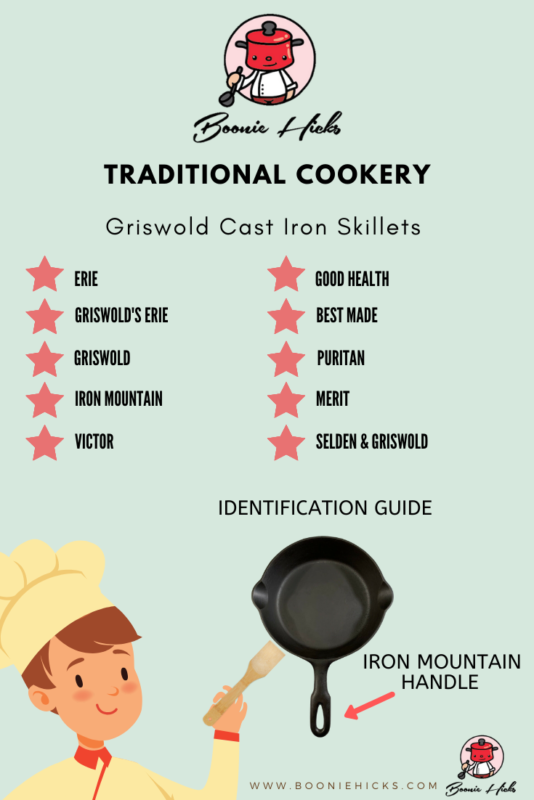
Griswold Manufacturing Background
Origins | Griswold Manufacturing Company dates back to 1868 when it was a small operation making door hinges. |
Selden & Griswold Manufacturing Company (1873-1884) | The Selden and Griswold family business became the Selden & Griswold Manufacturing Company. |
Griswold Manufacturing Company (1885-1957) | The company grew to one of America’s largest and most respected cast-iron manufacturers of the 20th century. |
Reasons For Collectibility | Cast Iron collectors highly regard Griswold cast iron skillets, and they are sought-after because of their smooth cooking surfaces and lighter weight. |
Desired And Rare Skillets | Look out for the first series of Erie and Erie Spider skillets. These two skillets stand out as the most sought-after by collectors. Also, rare sizes such as the Griswold #13 and #20 do not come up for sale often, but these large skillets can sell for a handsome sum when they do. |
| Most Valuable Griswold Skillets | The Erie Spider and Griswold 13 can cost a pretty penny. But the most valuable Griswold skillet is your family skillet. Family skillets vary in size and condition and have various logos. However, they are the most treasured and loved family heirlooms. |
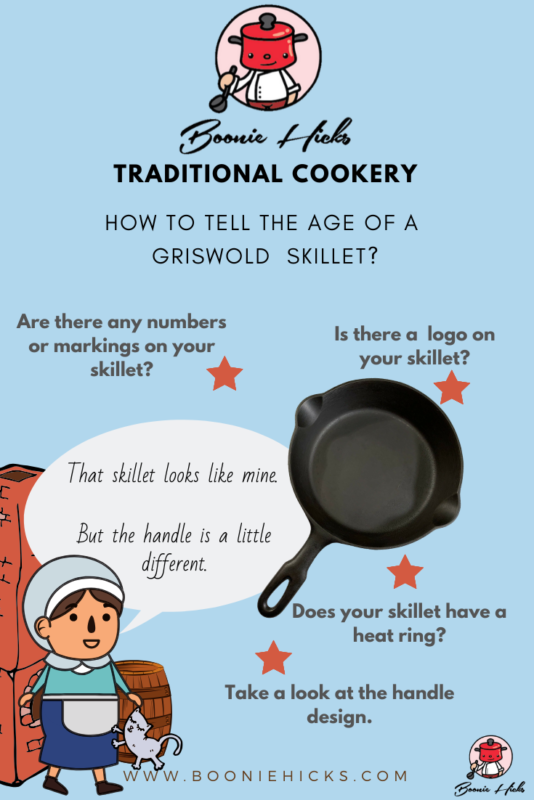
Selden & Griswold Cast Iron 1873-1884
Matthew Griswold and two brothers from the Selden teamed up and started to make door hinges in 1868. Their factory was known as the Butt Factory, named after the door hinge (butt hinge) manufactured in the casting works.
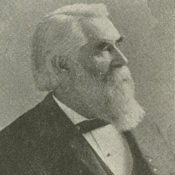
Selden & Griswold started to manufacture hollowware in 1873. But most of the cookware with this logo was probably made in the 1880s. Even though Mathew Griswold bought out the company in 1884, he still used the Selden Griswold logos.
After all, Griswold would have taken a lot of time and money to register new patent designs. And to make new molds. Check out our other article to learn about the history of Griswold Manufacturing. Wikipedia also has some information on Griswold. Although I hope my article is a little more detailed.
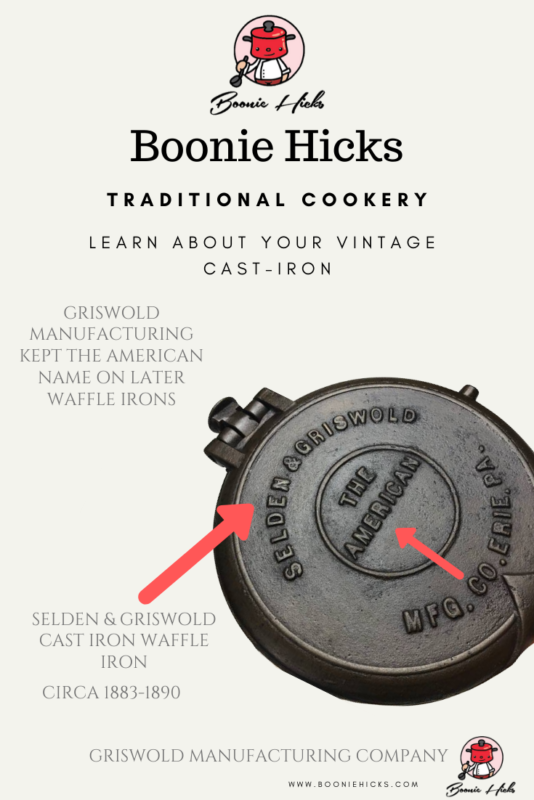
How Old Is My Griswold Cast Iron Skillet? Logo Approximate Dates
“Erie” Logo | Made around 1880-1907 |
Griswold’s Erie (Griswold diamond logo) | Circa 1884-1910 |
Style changed Griswold’s Erie | Circa 1905-1906 |
Griswold introduced a new logo design known as the circle cross logo. Slant Logo | With heat ring circa 1906-1916 |
Slant Logo With E.P.U. | Circa 1906-1929 |
Slant Logo Without Erie | No Erie under logo circa 1909-1920 |
Griswold With Large Block Logo | Without italic lettering, 1920-1930 |
Large Block Logo (Without Heat Ring) | Circa 1930-1939 |
Griswold Large Slant Logo (Without Heat Ring) | 1939-1944 |
Small Block Logo | Notable reduction in logo size. Circa 1939-1957 |
Erie Cast Iron (Approximation Date 1880-1907)
Erie cast iron is one of the most sought-after vintage cast iron brands you can collect. Griswold used this logo between 1880 and 1907.
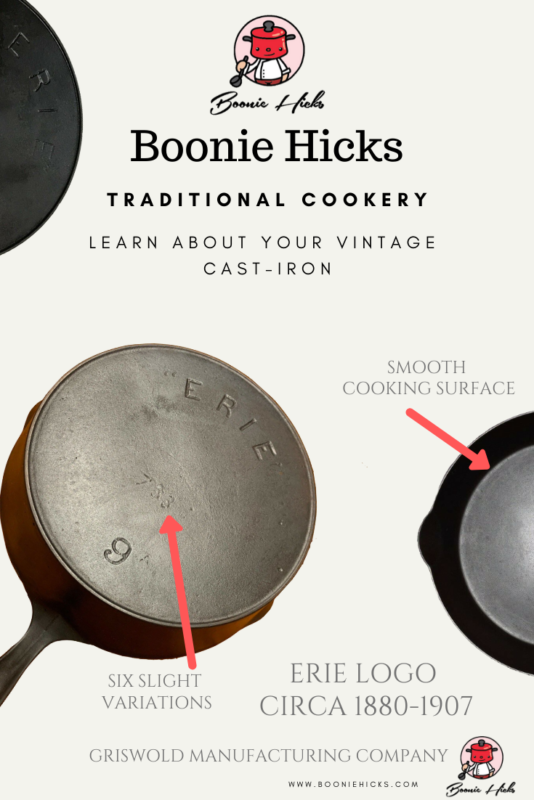
Erie cast iron skillets are very thin and light. Because of this, they are more prone to warping. So when you buy an Erie online, ask the seller if the skillet rocks or spins. That said, I would not look past an Erie skillet just because it has a little movement.
Erie skillets are also known to be super smooth and are often priced similarly to other vintage pans.
Some foundries used Erie skillets as a template to make their molds. So you may find Sidney Hollow Ware and Wapak Skillets with an Erie ghost mark.
If you have an Erie skillet, you can further break the Erie logo into six different variations. The Wagner and Griswold Society has an article on the markings and variations of the Erie skillets.
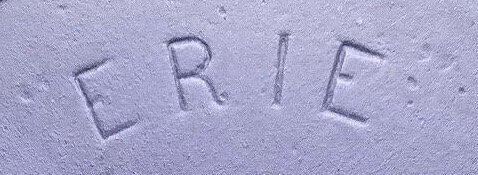
Diamond Logo
Look at the back of your cast iron Griddle, and if you see a diamond logo. Then it is your lucky day. The Griswold Diamond logo is an early logo that is more scarce than other logos.
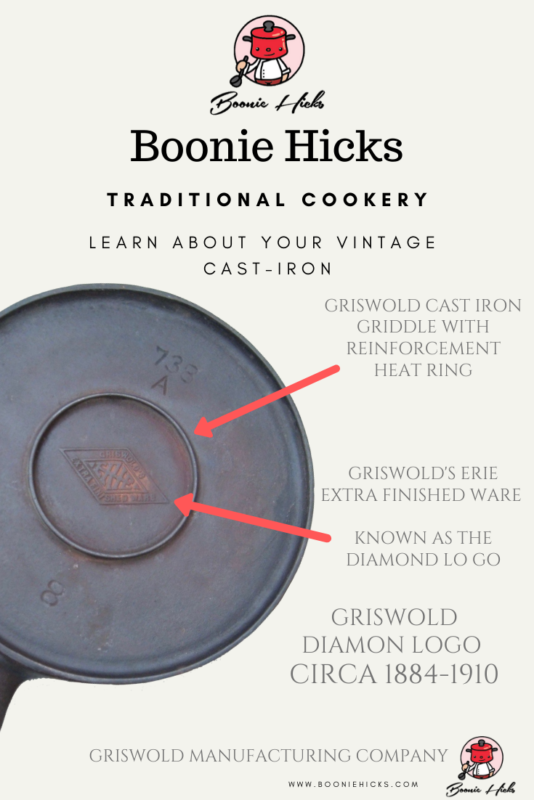
Griswold manufactured griddles with this logo circa 1884-1910. The logo is in the center of the backside. Unfortunately, the center is an area often damaged by sulfur pitting.
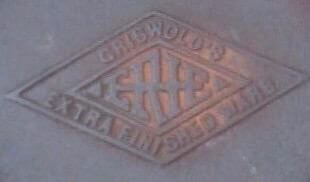
Griswold’s Erie Trademark
Griswold used this logo somewhere between 1905-1909. There are conflicting dates, so I used a conservative timeline. Since Griswold used the Griswold’s Erie logo for a shorter time, these skillets can be harder to find.
The Griswold’s Erie logo is the first Griswold logo. It transitions from previously used Erie logos to Griswold logos. However, Griswold’s Erie logo shares similarities with Erie skillets.
Sizes
Look for Griswold’s Erie skillets between sizes 6-9 and 11 to 12.
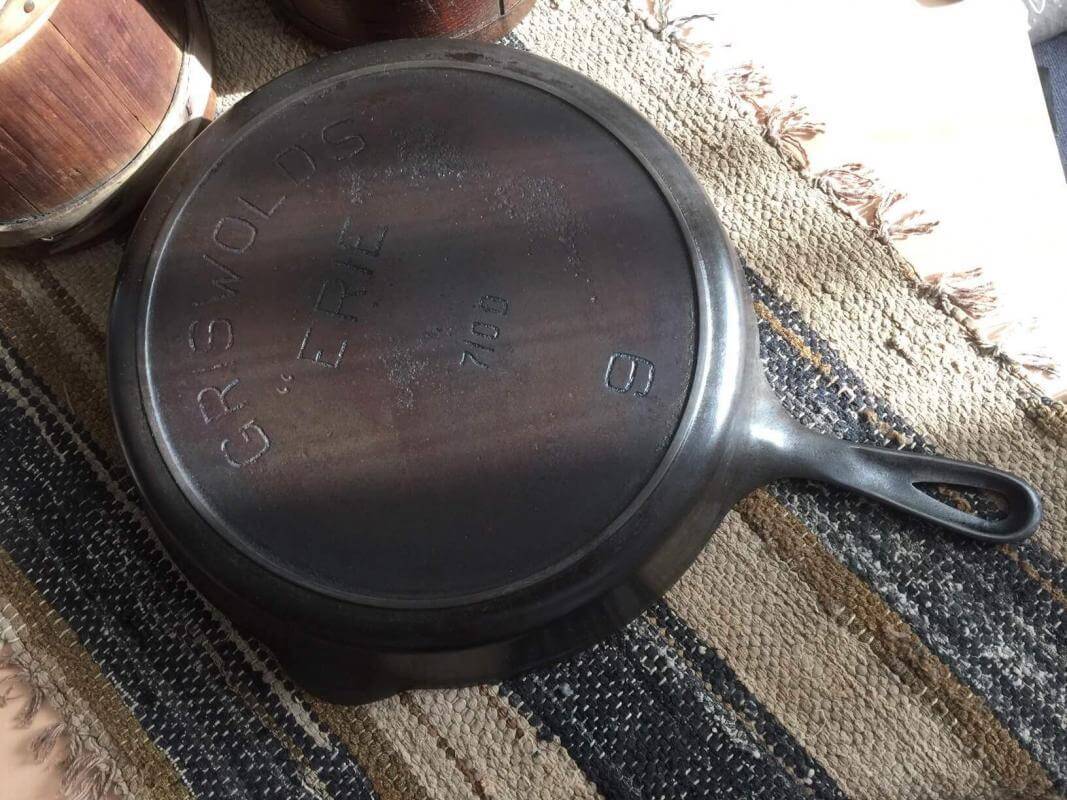
Griswold Slant Logo With Heat Ring And No E.P.U.
The slant logo is the first of the famous Griswold skillet logos. The Griswold Manufacturing company used the Slant trademark from 1906 to 1916. these dates give a slightly broad timeline, and cast iron enthusiasts would narrow this timeline down.
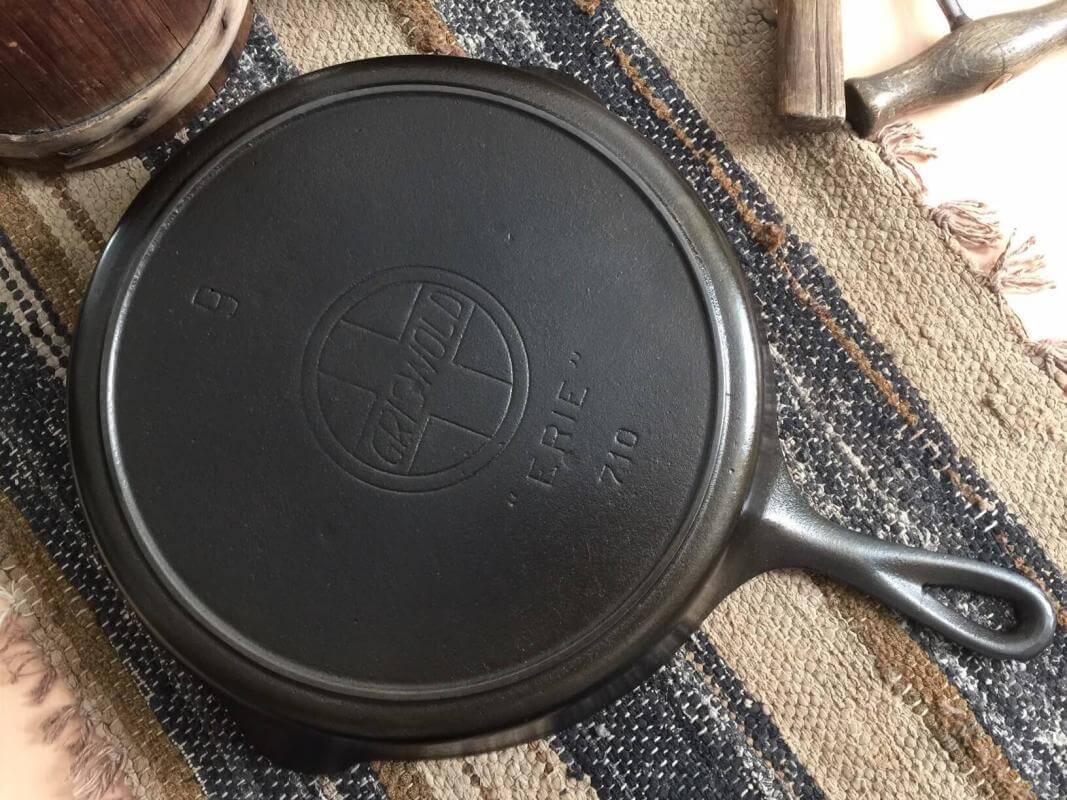
The Griswold slant logo is easy to recognize with the word Griswold in italics. Also, the Slant logo has characteristics that differ from Erie and Griswold’s Erie skillets.
Changes Griswold Made On Their Slant Logo Skillets.
- The size number on the base of the skillet moved from the 6 o’clock to 12 o’clock position.
- The word Erie is below the Griswold logo. The early Erie skillets have the marking at 12 o’clock.
- The pattern number moved from the center of the skillet to 6 o’clock on the skillet to make room for the Griswold circle cross logo.
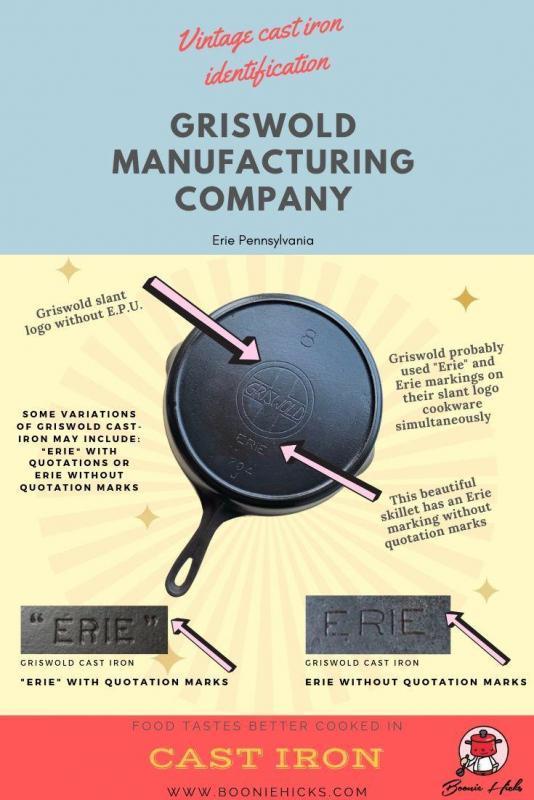
Griswold Slant Logo Sizes
Slant logo sizes range from 1-14. The largest skillet with the Griswold Slant logo is #14. A Griswold #13 slant logo can cost thousands of dollars to the serious collector. The skillet has to be in excellent condition to achieve this price.
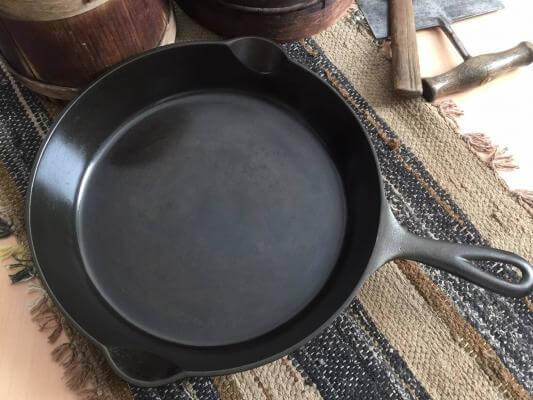
Griswold Slant Logo With E.P.U. And Heat Ring
The Griswold slant trademark changed to add the words cast iron skillet in an arc at 12 o’clock on the skillet. The E.P.U. refers to the wording Erie PA., U.S.A., on the skillet.
The slant logo, however, remained the same. Again, I cannot pinpoint the exact date of manufacture of the Griswold slant logo with E.P.U. If you have a Griswold slant logo with E.P.U., the manufacture date is around 1909-1929.
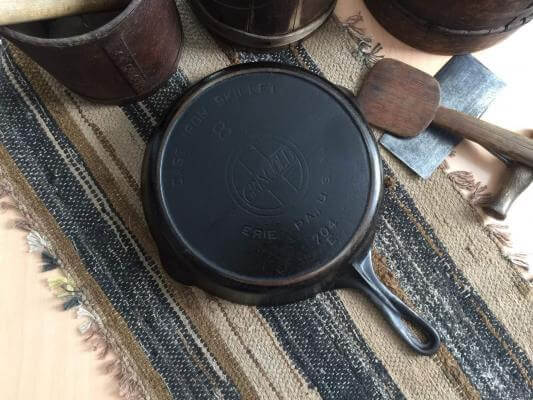
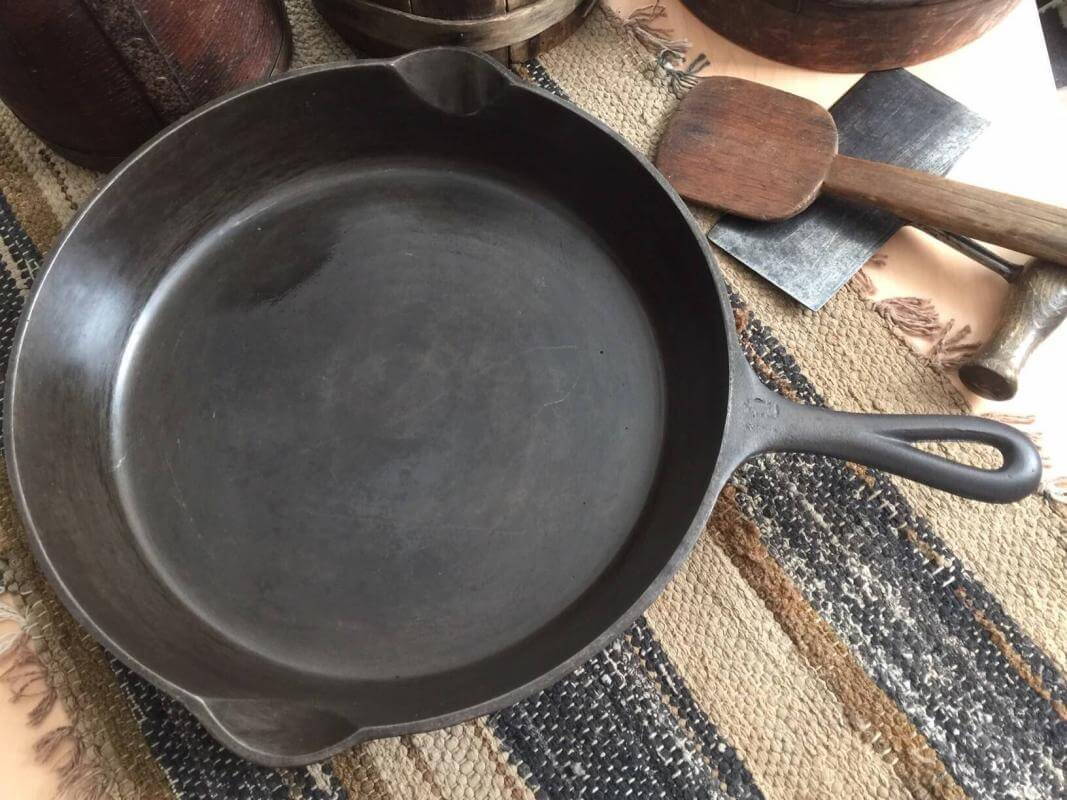
Slant Logo Without Erie Marking
I have only seen this trademark used on a few Griswold cast iron skillets. It seems to be quite rare. The logo is the same as the Slant logo without the E.P.U. wording on the skillet. This logo also omits the marking Erie.
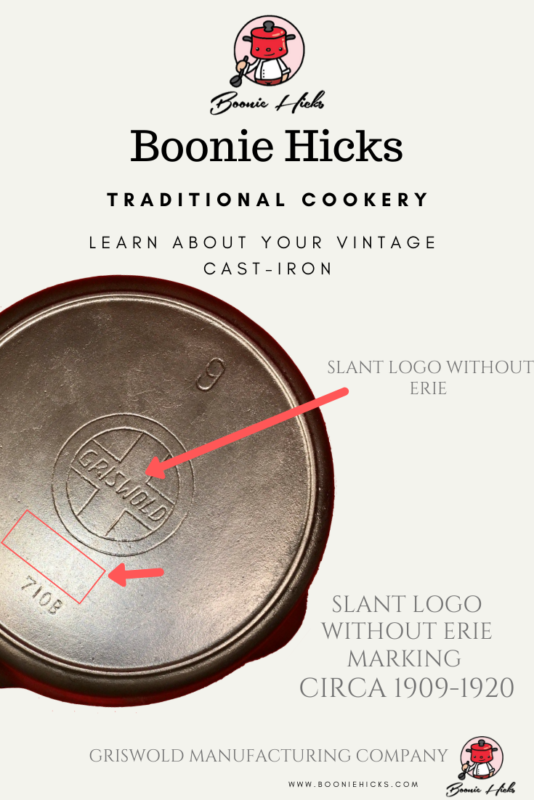
Griswold cast iron skillets without Erie marking have a manufacture date of around 1909 to 1920.
Sizes available: I have only seen the large slant logo without Erie on size #9 skillets. I do not know of other skillet sizes that came with this logo.
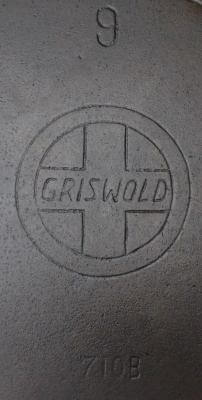
Large Block Logo (With Heat Ring)
The large block logo is one of the more popular markings or trademarks. It is known as the Griswold block logo. The block logo is very similar to the Slant logo. However, the word Griswold is no longer in italics. Griswold is in straight-block lettering.
Skillets with the block logo are circa 1920 and 1930. Griswold also manufactured a wide range of sizes ranging from 0 to 14. However, Griswold Manufacturing also made a number 20.
The Griswold #20 is a massive skillet and can cost a pretty penny online. It is called the Griswold Hotel Skillet.
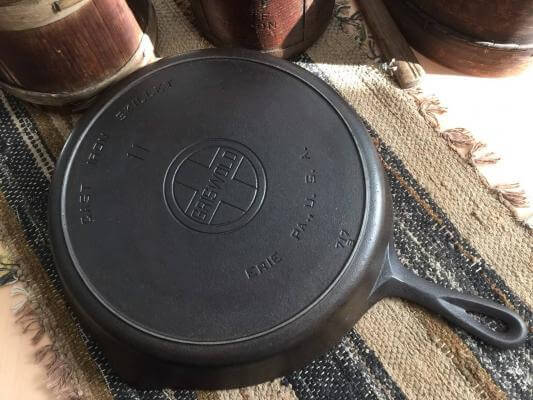
Large Block Logo Without Heat Ring (Smooth Bottom)
Griswold also put the large block logo on cast iron skillets with a smooth bottom rather than the familiar heat ring. However, the sizes were more limited. Look out for sizes between 2 and 10 to collect a complete set.
Smooth bottom skillets are not as sought-after to collect as skillets with heat rings. So you can expect to pay less for a Griswold without a heat ring.
Why the change? Cookware with heat rings was for use on wood or coal ranges. However, with the introduction of electric cookers, cast iron cookware with heat rings slowly gave way to cast iron skillets without heat rings.
Do you want an excellent old skillet without the price tag of highly collectible pieces? Then, using a skillet with the Griswold Large Block trademark could be a great option.
Griswold made skillets with the large block logo and a flat bottom between 1930 and 1939.
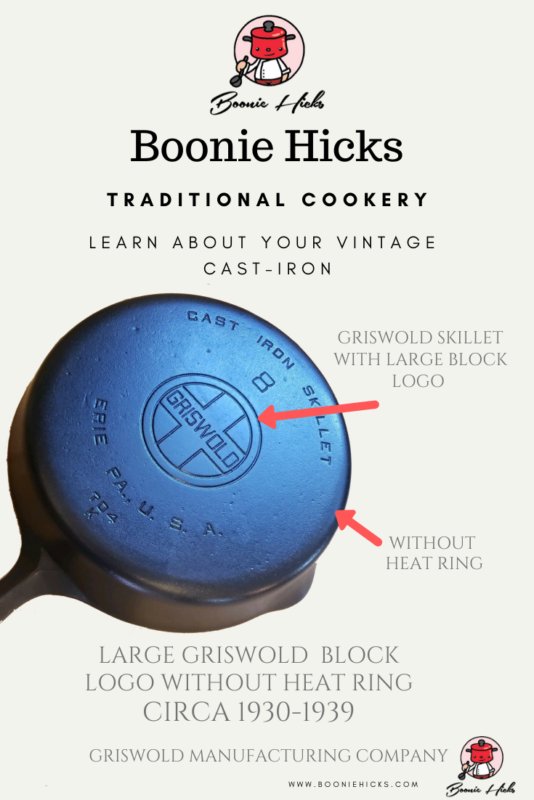
Griswold Slant Logo Without Heat Ring
Griswold also used the Slant logo on smooth bottom pans.
However, slant logos on skillets without a heat ring are not as common as skillets with a heat ring. These pieces sell at a similar price to a smooth bottom Griswold with a block logo. Griswold made these skillets between 1939-1944.
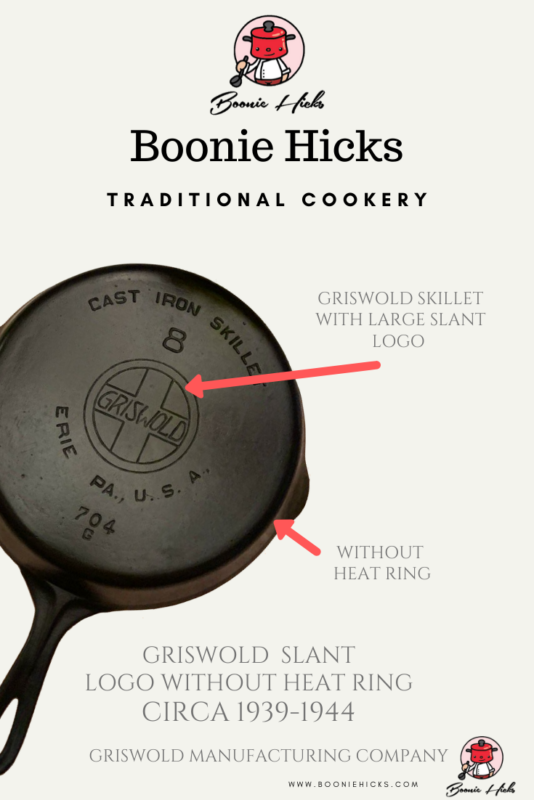
Small Block Logo.
The Griswold Small Block marking is not as collectible to cast iron enthusiasts, but they are still fantastic skillets. Griswold drastically reduced the size of the logo, and skillets came without a heat ring. Skillets lost much of their character. But there are some beautiful skillets around with the small block logo.
Watch out for sellers pricing these skillets at high prices because you can expect to pick up a skillet with the Griswold small block logo at a lower price than more collectible skillets.
That’s not to say the small block skillets are any good. But the small block logo is not as collectible so that you may pick a good skillet at bargain prices.
The Small Block logo is from circa 1939 and 1957.
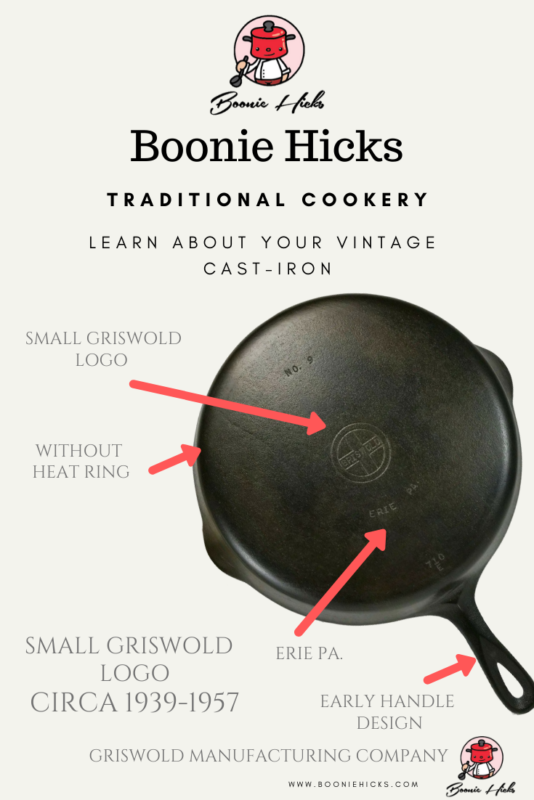
Do you have a skillet with a small block logo? Then check out this article. You will learn three different handle types to estimate the age of your skillet better.
Griswold Manufacturing’s Big Brands Were Erie And Griswold. But They Also Made Cast Iron Cookware Under Different Brands.
The Griswold Manufacturing Company, like other foundries, made a lower-grade range of cast iron cookware and was more budget-friendly.
Griswold Manufacturing Budget-Friendly Line.
Victor | Circa 1890s to the 1930s. |
Iron Mountain | Circa 1930s-1940s. |
Victor Cast Iron is A Budget-Friendly Brand Manufactured By Griswold.
Victor was a budget-friendly line of cast iron. Griswold made Victor Skillets between the 1890s and 1930s. The logo has also changed over the 50 years, with Victor at the 12 o’clock position like Erie skillets. However, the Victor logo on the cast iron skillets became embellished over the years.
Griswold Manufacturing marketed Victor cast iron as a lower grade. But this does not mean lower quality. The skillets still have super smooth cooking surfaces.

Do you have a piece of Victor ironware? I have written an identification guide to estimate the age of your pan. Click on the link to learn more.
Iron Mountain
Griswold made another lower-priced range of cast iron known as Iron Mountain. Unlike other cookware made by Griswold Manufacturing, the Iron Mountain range does not have a logo or trademark on the ironware. Without any markings, it is harder for non-collectors to identify the skillets.
But there are a few characteristics that the Iron Mountain skillet series has that can identify them. Look for a rectangular hole in the handle.
Griswold made Iron Mountain cast iron between the 1930s and 1940s. Since Iron Mountain cast-iron was a budget line, it is probably not a surprise Iron Mountain skillets have a heat ring for use on older wood and coal ranges.
.
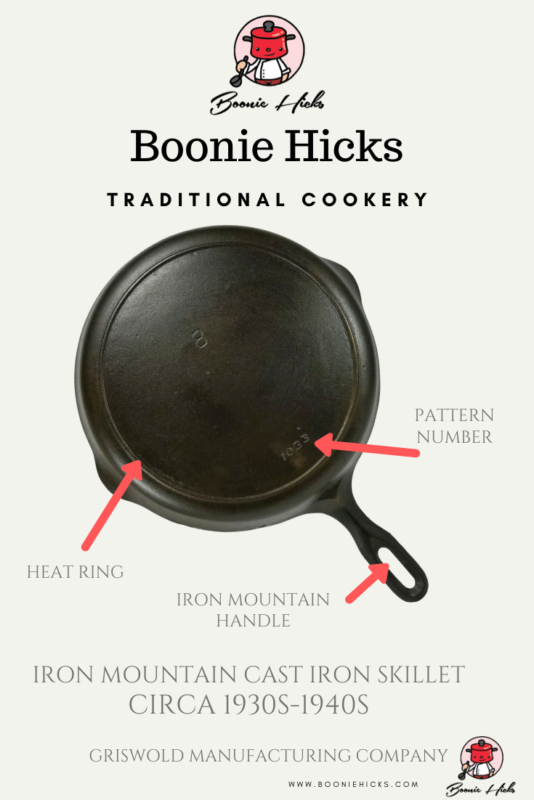
Griswold Manufacturing Made Skillets For Other Companies.
Sears contracted with Griswold Manufacturing Company to make cast iron cookware for their department stores. The Cast Iron Collector also has information on cast iron store brands. Griswold store bands that included.
Store brands manufactured in the Griswold foundry.
Best Made | Manufactured in the 1920s |
Puritan | From the 1920s to the 1930s, Griswold Puritan cast iron had a pattern number at 6 o’clock. If you have Puritan cast iron, click the link to learn more. |
Good Health | Made from the 1920s to 1930s |
Merit | Circa 1920s-1940s |
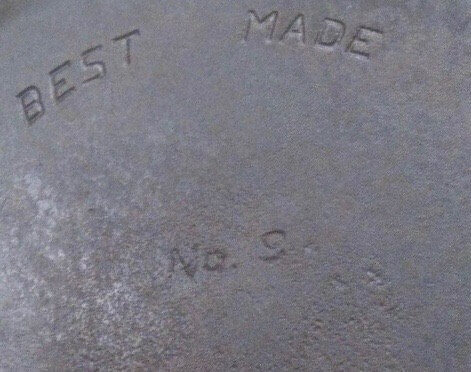
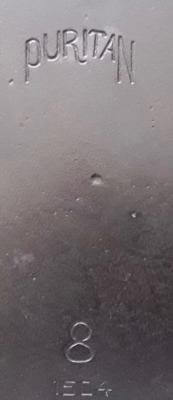
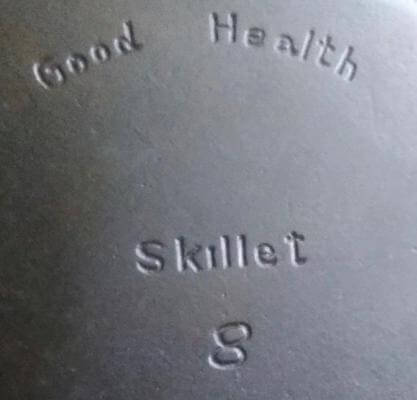
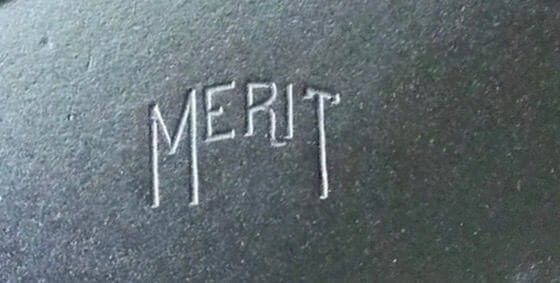
Griswold Skillets Are Great, But Take Your Time Buying One.
Suppose you have a Griswold Cast iron skillet. Then you should be one proud owner. Many pay a premium for Griswold cast iron skillets. However, the word is out Griswold to the name to collect. And some sellers are asking hefty prices. Just take your time if you want to buy one of these beauties.
Griswold Made Other Brands.
Do you have an Erie or a Griswold? Then you have yourself one fine skillet. But the store brands and the Iron Mountain range are good as well. Even though smooth bottom skillets are not as collectible, many prefer them on modern hobs.
There is good reason Griswold has the reputation of making some of the best antique cast-iron you can cook with.
Enjoy your skillet.
Helpful Articles For Further Reading On Griswold Cast Iron.
Once you have finished reading this article, I have written beginner’s guides to Griswold skillets. To help non-collectors use and enjoy their Griswold ironware.
- Where are the best places to buy Griswold ironware as a novice?
- How can I spot faults in the skillet and avoid overpaying?
- Is my antique skillet worth anything?
- Should I buy a Griswold cast iron skillet?
If You Have Enjoyed This Article, Check Out My Other Articles On Vintage Cast Iron.
- Wagner Wagner was Griswold Manufacturing’s main Competitor.
- Wapak Hollow Ware used Erie skillets for templates for their cast iron skillets.
- Favorite Stove And Range made excellent cast iron. Favorite Piqua Ware, in my opinion, is equal to Wagner and Griswold.
- Sidney Hollow Ware is one of my favorite makers. They also made their cast iron extremely light.

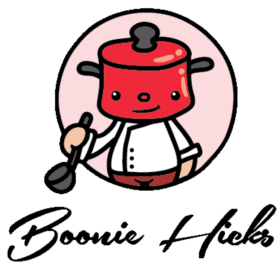
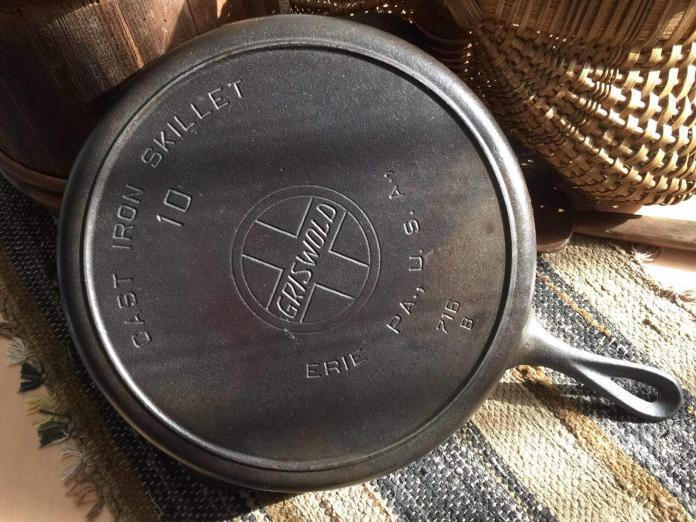
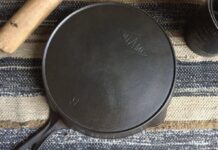
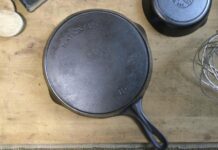
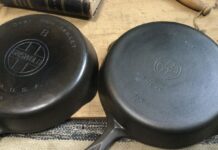



I’ve got one that has Wagner and Griswold both on the bottom.Its 11′ #8
Hi E. Hall
It sounds like you have a Wagner made pan which is known as the dual logo in the cast iron community. Unfortunately these pans are not currently as collectable as the older skillets made by either Wagner or Griswold. However, they seem to be fairly scare and I seldom see them for sale. I guess it has Made in USA under the Griswold logo so it’s made after 1960.
I’d date your pan circa early 1970s.
Cheers for getting in contact, enjoy your vintage ironware.
FYI. I just acquired 30+ pieces of Griswold. The Scotch Bowl has the slanted Griswold that you talked about in your article. Would that date the pot 1906-12?
Marked Slant, Large Logo, GRISWOLD, 4, ERIE, 782A. Bottom Ring, Handle. Ring on pot. Very good except needs cleaning.
If this will help in your research, I’d gladly send you a picture.
Hi Geoff
Wow, that’s a nice haul of Griswold cast-iron. It sounds like you’ll be busy over the next few months cleaning and restoring these little beauties. Thanks for sending a detailed description of your Scotch bowl. The number 4 is a very usable size.
I’d place your Griswold Scotch bowl Circa 1906-1916 but I admit my dates are a little conservative. But I think Griswold were manufacturing a Scotch bowl with the slant logo and no E.P.U. during this time.
If you could send a photo and possibly help this resource, I’d be very grateful. Here’s my email if you have time. booniehicks@gmail.com
Hope this helps, all the best with your restoration project.
I have two of my mother’s old skillets. First one is a small logo#9. It is marked,
11 1\4 inch skillet
Made in USA
A
There is also an A on the underside of the handle.
The second skillet has no logo and is marked
10 1/2 inch skillet
Made in USA
It also has a V on the underside of the handle. The handle is identical to the other skillet. It is a #8. Any help identifying them will be appreciated.
Thanks
Tom
Hi Tom
Hey fantastic, I’m sure your mother is really pleased you’re researching her old skillets.
I’d place a guess your Griswold and unmarked skillet were made by Wagner Manufacturing after 1957. Wagner purchased Griswold Manufacturing but continued to make Griswold branded products in the Wagner foundry. You’ve probably noticed your Griswold skillet is doesn’t have the markings Erie P.A. so I’d say it wasn’t made in the Griswold foundry. Wagner also made a lot of unmarked skillets so I think you may have a couple of Wagner skillets, very nice.
Thanks for reaching out, enjoy your skillets.
Thank you. Both cook really well even though the Griswold marked one is a spinner. I got them cleaned and reseasoned. Ready to hand them down.
Hello-
I have few Griswold skillets, and I just love how versatile they are. Can you tell me about lids? Did Griswold manufacture lids for them? If not, can you recommend some appropriate lids that can handle the high baking temps?
Hi Denis
Thanks for the question.
Great to hear you’re enjoying your vintage pans. Griswold made lids for their skillets. And if you’re cooking at high temperatures a cast iron lid is the way to go. Check out Ebay for an indication on selling prices. Unfortunately, Griswold Skillet Covers are a little scarce and command a high price.
But half the fun of collecting vintage cast-iron is finding a hidden gems at garage sales and Goodwill stores.
Good luck
Hi, can you tell me if a glass Griswold dutch oven lid can be used in an oven? Or do I need to use a cast iron top on my dutch oven? Thanks for any help you can give.
Hi Joesph
Thanks for the question.
I don’t have any glass lids on my Dutch Oven so I cannot speak from experience.
Both vintage and modern glass can crack at any time even shatterproof glass. Heat resistant cookware was developed in the 1800s.
Vintage glassware was made from a mixture of Boron and Silica called Borosilicate. And it’s probably more prone to breaking than modern glassware. Today Lime Soda Silica is used and for a couple of good reasons.
1. It’s less likely to break.
2. Modern glassware is designed to shatter into smaller pieces and is less likely to cut.
So if you use your Griswold glass lid please be careful especially around the rim where you may not notice small chips. And use the lower oven-rack to avoid the broiler effect. Here’s an interesting article by Anchor Hocking
Cheers hope this helps.
I have a 5 qt dutch oven that has the Griswold logo in the center and a Wagner Ware logo above it. Any information you can give me would be appreciated.
Thank-you!
Hi Joann
Thanks for your question.
Your Dutch Oven was made by General House Wares when they owned the rights of both Griswold and Wagner. As a rough guide your oven with dual logo was probably made between 1970-1975 and I think it originally came with a glass lid.
What a neat oven, I hope you gets lots of use out it.
Enjoy
Hi Boonie, I hope you can help
I have two cast iron skillets that were my Grandmothers.
Skillet 1. CAST IRON SKILLET at the 12 o’clock position GRISWOLD logo inside of 2 rings about 4 inches around at 6 o’clock ERIE PA U.S.A under that appears to be P04 and 8 on the top side base of handle.
Skillet 2 reads Good Health at 12 o’clock, Skillet in the center and 8 under the word skillet. Also there appears to be 658 at the 6 o’clock position.
I just want to know the approximate date of manufacture. Thanks for your help
Hi there Diane
Your Grandmother will be very happy that you are researching her skillets.
You can see both examples of your skillets in the article. However, the first skillet is the oldest and most collectable, it’s circa 1924-1940 a #8 is a very usable skillet. The P04 is a pattern number of the mold.
The second skillet I don’t see too often and it’s a little later than your first skillet. They were made circa 1920s-1930s.
Both are very nice skillets. I bet you make some very fine meals with them.
Happy Cooking
I bought four badly rusted cast-iron pans a couple days ago from someone on a tag sale site. Two Wagners and two Griswolds.
My clean Griswold it wasn’t rusty like these others, but it had years of caked-on deposits (both inside and out) that I scraped/buffed/cleaned off. I also have a Griswold deep-fryer (with basket) that was more rusty than caked-on that is also now in great shape after cleaning it. They are both great cookware pieces now. Any good methods recommended for cleaning the pans I bought?
(GAH! I can’t find a way to post the picture. Am I missing something?) Would still appreciate good method(s) for cleaning other than the major elbow-grease employed on the last two reclaims.
Thank you for the informative article.
Hi there Michael
Thanks for the question, unfortunately you can’t send photos in the comment section. However, you can send them to booniehicks@gmail.com I’d like to see your restoration project.
1. The best method is probably electrolysis and it’s favored by many cast-iron enthusiasts since it’s gentle on the metal. However, there is a little setup cost.
2. If your oven has a self-cleaning mode you can set your oven to self-clean with your ironware inside. Best to do this on a fine day with the windows wide open. There will be smoke but the seasoning should burn off. Or you could slowly bring your oven to a high temperature and allow the oil to burn off your pans. Best to line the base of your oven with foil for easy cleanup.
3. Oven cleaner spray. Again it’s best to this outside. Spray your pans with oven cleaner and put them into a plastic bag for a couple of days. The active ingredient is lye which was used in soap making and it should lift all but the most stubborn layers of seasoning. Some people are hesitant with this method because chemicals are in contact with the cooking surface.
I’d favor number two if there’s not too much buildup. There’s no chemicals or batteries to worry about. Youtube should have some good videos for you to watch. To keep your pans in original condition and to hold value stay away from the grinders in your restoration.
These vintage pans are a little piece of history and culture. Good on you for bringing them back to usable condition.
Have fun with your project
Brett (Boonie)
My mother-in-law left behind a 9″ Griswold skillet. It only has the Griswold emblem with the cross. It has been used so much that I can’t tell if there was anything at 6 o’clock position and there is nothing at the 12 o’clock position. It does not have a heat ring. From what I am reading, it could have been made within a couple of time periods. My mother-in-law passed while in her 80’s in 2005. I was told that it was handed down from her mother. Can you help me identify the time period it was made?
Hi Pam
Thanks for the question
I’m sure your mother-in-law is very happy you are taking good care of her skillet.
Since your Griswold 9 inch skillet doesn’t have a heat-ring and with no discernible writing, I’d say you have a small block logo. And I’d place your skillet made around 1939-1944 if the handle looks like a tear drop and 1944 to 1957 for a handle that looks scooped out.
I have a picture on the article. Just scroll up and you’ll be able to compare it with your skillet.
Hope this helps
I have a 10.25 inch cast iron skillet that I am trying to identify. There is an 8 engraved on the top of the handle near the base. On the bottom of the skillet is recorded: Long Life Skillet with the number 1758A on it. The handle has a round hole in it. Any information you could provide would be appreciated.
Hi Mike
Thanks for the contact.
Sounds like your skillet was made by Wagner Manufacturing and is circa 1930s. It was most likely marketed as budget friendly option to Wagner’s standard product line. If you have time you may find this article on Wagner Cast iron interesting.
I just picked up an Erie 12 inch bail handled griddle with the inset heat ring. Below ERIE (no quotes) is the number 847. These are at the bottom and the 12 is at the top underside. The center of the underside of the griddle has a bit of iron which protrudes out about 1/2 inch and is threaded inside. This prevents the griddle from setting level on a stovetop. Can you tell me the purpose of this and anything else you may know about this piece would be helpful as well?
Hi, thanks for your question Larry
It sounds like you have the griddle part of an Erie Gas Griddle. Originally, it would have come with a base which fit together. Properly used to diffuse heat.
Even with today’s modern stoves and cookware, some people use heat diffusers to distribute heat and better control the temperature on gas stoves.
If you have a chance to go back to where you picked up your griddle and search for the base it could be worthwhile. From my understanding, they are rare pieces. Your griddle most likely was made between circa 1905-1940.
Good luck, I hope you find the base.
I am looking for information on a Griswold No. 34 Patty Molds. I am guessing they were manufactured around the 50s and 60s but I am having trouble finding any information on how to date them. I have seen the item called a pancake pan or a plett pan. On the bottom left hand side of the pan it has the numbers 2980 with the letter A beneath it. I am just curious of the date range when this pan was manufactured.
Thank you
Hi Melissa
Thanks for your question. It sounds like you’ve done your research. I’d also say your Griswold Plett Pan was made in the 1950s or 1960s.
From your description, your version of the pan was probably manufactured after 1957. Which is after the Griswold family sold their interests in the company. Griswold probably manufactured Platt pans in the Erie P.A foundry from 1910s-1950s.
Sounds like quite a few American households were enjoying pancakes on the weekend. That’s the good life.
Thanks, enjoy your pan.
I have a Griswold no 9, slanted Griswold,3/4 inch Erie, logo,710D, no 9 on handle, would have an idea of the age. Thank- You. Mark.
Hi, Mark thanks for sending a message.
Those Griswold slant logo skillets are some good looking pans. From your description, it sounds like your skillet is without Erie PA., U.S.A.
From my understanding, Griswold made this version of the logo around 1906-1912.
If you are wondering the meaning of the 710D at the base of your skillet. The 710 is a Griswold No9 skillet and D is the mold used.
Enjoy your skillet
Hi, my skillet is without the E.P. U.S.A.logo and it has a heat ring. It is a different size from other descriptions. They made different styles the same years? Thank you. Mark
Thanks for getting back in touch Mark
There’s quite a bit of overlap in some of the logos. I guess there was a lot less waste back in the day and they used molds for as long as they could.
Mark if you can please send a picture to booniehicks@gmail.com I can double check the logo for you. I want to make sure it’s a slanted Griswold logo. But reading your description again it could be a older Erie logo. If I can see a picture hopefully I can point you in the right direction.
Cheers
I have a Griswold Number 8 Dutch Oven with a glass lid that I inherited from my mother-in-law, who got it second-hand sometime in the mid-1950s. Unfortunately, the lid was accidentally broken recently.
I obtained an aluminum lid (which fits perfectly) that I know nothing about. There are three rings on the inside of the lid. At the bottom of the outer ring it says A 465 C and underneath that is the letter N. The top of the middle ring says TITE-TOP DUTCH OVEN and at the bottom ERIE PA., U. S. A. At the top of the inner ring is the number 8, in the center is a large block GRISWOLD logo and underneath that PAT’D. FEB. 10. 1920.
Can you please tell me something about it?
Hi John, thanks for getting in contact.
I’m sure your mother-in-law is very happy that you are taking care of her old Dutch Oven. If your oven doesn’t have a bail handle it’s not missing Griswold made this style TITE-TOP with glass lid without a wire handle. I’d place your oven circa 1940s-1950s.
Picking up an aluminum lid was a good idea. From my understanding, Griswold used the same pattern for their cast iron and cast aluminum cookware. So it should fit as snugly as an original lid.
Your description is very clear. A=aluminum, 465=No.8 aluminum Tite-Top Dutch Oven and C=cover. The letter N indicates an individual mold used in production. Although I must admit, I’m not too familiar with the Griswold aluminium cookware range.
Unlike modern manufacturers such as Le Creuset, Staub and Vermicular which advertise their tight-fitting lids as a premium product. Griswold advertised their TITE-TOP-Ovens and braisers which were made in both cast iron and aluminum for good family economy. Because you could cook lower-priced cuts of meat in the oven.
Hope this helps
When my mother passed, she left with two Erie Griswold cast iron skillets that are very much alike. On the bottom of each of them there is a number 9 at the top, the Griswold slanted logo in a cross in the center, the word ERIE beneath the logo, the number 710 under Erie, and a raised heat ring, and no numbers on the handle. The different is as follows. The one with the number 710D doesn’t have quotations marks around the word ERIE. The 710C has quotations marks. Please, tell me about each of them.
Hi Karen
Thanks for the contact, I’m sure your mum is very happy that you are researching and treasuring her antique skillets.
It sounds like you have two Griswold skillets known by enthusiasts as the Griswold slant logo without E.P.U. (Erie Pennsylvania U.S.A.) Most of the skillets I’ve seen with this logo are without a number on the handle like yours.
From my understanding, Griswold used “Erie” with quotation marks and Erie without quotation marks interchangeably on their Griswold pre-E.P.U. slant logo range. I’m not sure as to the reasoning for this, but your No9 710C and 710D skillets were probably made around a similar time. 710 indicates the number 9 skillet, and the letters C and D indicate an individual mold. Circa 1906-1912 for the larger 3.5-inch logo, or 1909-1920 for the smaller 2.5-inch logo.
Thanks it’s a great question, I’ll add a picture to the resource.
I have a family Erie P.A. U.S.A. Griswold number 7 pan (also on handle), 701 J, large block letter, no bottom ring. Can you tell me anything about this?
Hi Melissa,
Thanks for the question. From your description, I’d say your family pan was made somewhere between 1930 to 1939. However vintage pans are hard to date with any certainty another resource places this logo used between 1924-1940 so please take dates as an approximation.
After researching, I couldn’t find any Griswold skillets with a smooth bottom made before this time. This could mean more people were using gas or electric ovens instead of wood ranges around this time which is very interesting.
Happy cooking
I’m looking at a Erie number 9 739 x bottom with the slant logo with a center ghost mark is this a valuable or rare griddle? Asking price is $85 plus shipping it appears to be and very nice condition I know evaluating value on something unseen is hard at best! But I would appreciate your opinion on this unit thanks in advance Ed Brown
Hi Ed
Thanks for getting in contact
I think a lot of collectors hesitate to value vintage cast iron, myself included. There’s a lot of cast iron around in varying condition. Also, you hear of stories of people picking up vintage cast iron for next to nothing at flea markets while time and effort of professionally restored pieces need to be considered, making valuing difficult.
There are a few variations of the reinforced X griddle. However, from your description, this type of griddle was made around 1909 could present fair value at this price. Although, I would check the sold listings on eBay to find out the current selling prices. Ghost marks are always interesting. Just to confirm:
9 placement top
“Erie”
739
Big raised X
Griswold Slant logo
I recently bought a #12 slant logo ERIE. I’ve owned regular #12s slant erie with and without the assist handle on top… The one I just bought has a assist handle with two finger grip holes inside the assist handle. Other than having it confirmed it is real and factory Griswold made by others and from what I can see face to face I really cant find any other info on it? Was wondering if u knew any info on it and if they also did this to other sizes with assist handles on top like the #14?
Hi John
Thanks for leaving a message. It sounds like you have a loop finger handle. I’ve only seen this style on Wagner skillets. But apparently, Griswold also used the loop handle on a couple of their skillets as well.
If I have your description correct, your skillet probably was made in the 1920s later than the slant Erie logo. It appears Griswold made this scarce version of the assist handle on their number 12 and 14 skillets.
Hope this helps.
My mother has a Griswold slant logo without EPU and heat ring with 11 in the 12 o’clock position, Erie under the center cross Griswold slant logo, and 717 at the 6 o’clock position however it does have 11 on the handle. I haven’t seen any other slant logo without EPU with the handle stamped but hers sure is! Is this an unusual variation?
Hi, Tammy, thanks for the comment and sharing with the readers.
I’ve never seen an early slant logo without an EPU but with a number on the handle. I had to do a bit of google searching myself. You’re right, they seem to around be not very common. Very cool.
Griswold number 11 slant logo is a very nice skillet. Your mother is one lucky lady.
Hey, thanks for sharing, really appreciate it.
Hi we picked a really cool Griswold pot with an orange lid and black handle . It’s marked with the cross and circle with Griswold in the cross and a small R with a circle around the R. It also has 2QT and 92 on it . Was is the piece used for and what’s it value? We plan to use it as an ice bucket. Thanks for any info
Hi Michael
Thanks for getting in touch.
As someone who enjoys vintage cookware your piece is very exciting. Unfortunately, I don’t touch valuations, But I believe you have a piece of modern cookware from the 1960s, designed by Peter Muller-Munk.
Very cool
I picked up and number 8 Griswold smooth bottom small center mark, Erie PA. 704-F. What does the f stand for ? I noticed there’s a lot of different letters following the number, PS I enjoyed reading the information you provided in thanks again
Hi Ed
Thanks for your comment. I’m glad you enjoyed the article.
From my understanding, those letters are called “pattern letters”. Pattern letters were used to identify a mold used in production.
Why did they use pattern letters? For quality control. If there was a problem with one of the molds, Okay which mold was it? The workers could look at the pattern letter to identify which mold it was and remove it from production.
Hope this helps.